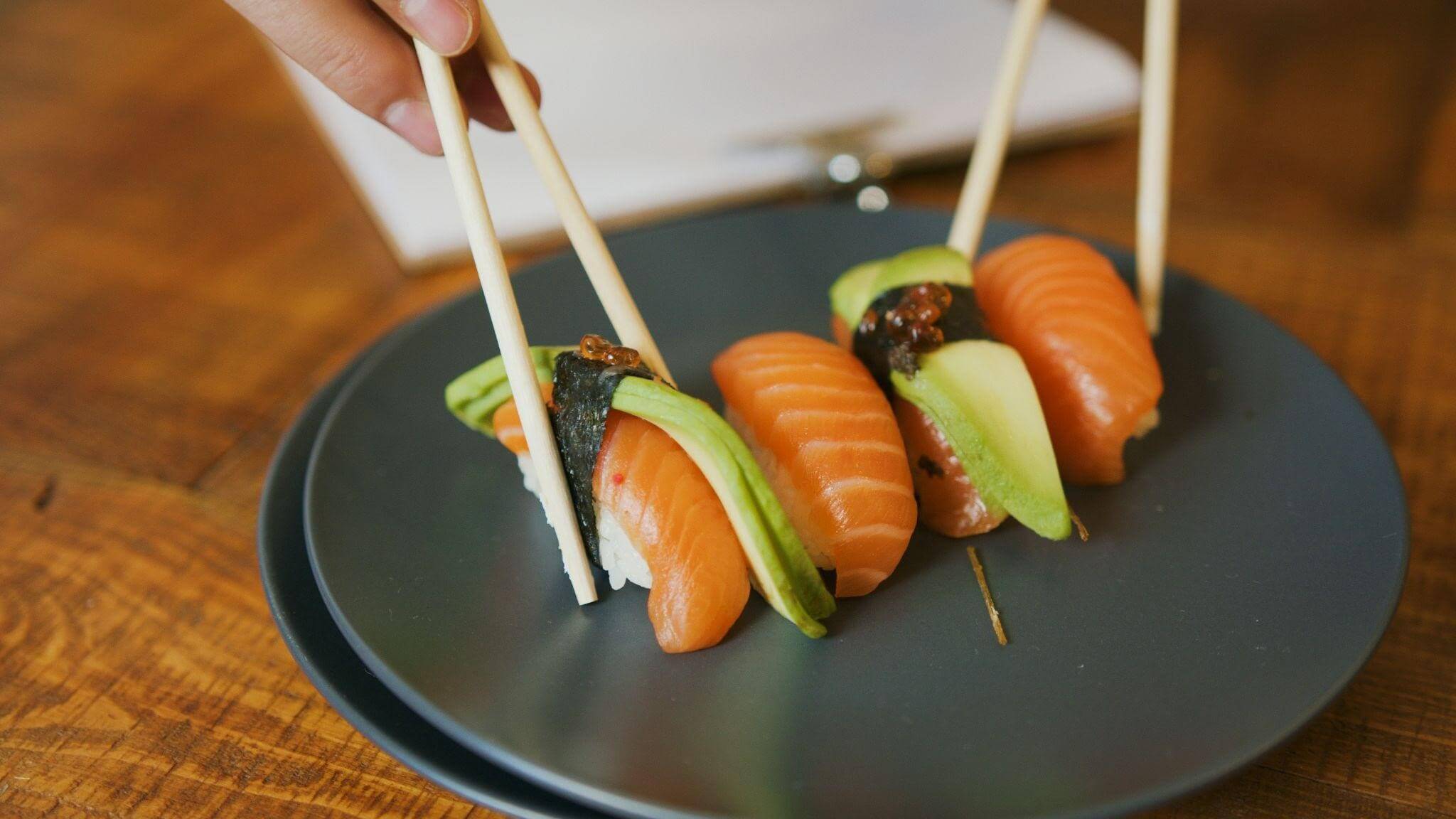

NYE ORDERS ARE NOW CLOSED!
Delivering in the New Year, direct to your door. Order online and check out.



As with sashimi, it’s just as acceptable to eat nigiri with your hands as it is a pair of chopsticks.
Sushi is a traditional Japanese dish that has greatly evolved in terms of flavour. While most of us have heard of sushi—having tried it at least once or eating it on a regular basis—not everyone is familiar with the nuances of its different forms.
One popular type of sushi is nigiri—sometimes confused with sashimi. Although both can be made with raw fish, they’re quite different in terms of presentation, taste and texture. Not to mention that only one type can use seared or cooked fish while the other can only use raw fish.
Want to impress your friends and family the next time you visit a sushi restaurant? It pays to have some knowledge of Japanese cuisine.
Nigiri sushi consists of a small, hand-formed ball of vinegar rice with a thin slice of fish, shellfish or other toppings, typically wasabi and shiso leaves, on top. The term ‘nigiri’ translates to ‘two fingers’ and it’s named as such because sushi chefs traditionally make it by pressing the sushi rice together with two fingers before adding the toppings.
To start, the sushi chef seasons the sushi rice with vinegar, sugar and salt. They mix the rice by hand to achieve the perfect texture and then form it into small oval-shaped balls. Finally, they add the slices of fish, pressing them firmly onto the rice.
Nigiri is often served in twos or threes, with each piece featuring a different type of fish. Such a simple yet elegant presentation allows the freshness and flavour of the fish to shine through.
Nigiri sushi can be made with different types of fish, including bluefin tuna, salmon, yellowtail, red snapper and octopus. The fish used in nigiri should be fresh and high-quality to ensure a smooth taste and texture.
Some sushi restaurants offer non-fish options, such as beef, chicken and other meats. Others even have vegetarian options in their sushi menus (e.g., nigiri made with shiitake mushrooms or shiso leaves)
Unlike nigiri sushi, sashimi is a Japanese delicacy that consists only of raw fish or seafood and is not served with rice. Instead, the smooth taste of the fish is complemented by the salty, umami taste of soy sauce and the tangy taste of pickled ginger.
Sashimi is typically made by slicing the fish into thin, bite-sized pieces and arranging them on a plate, often in a decorative manner. It’s served cold and in larger portions, either of a single or type of fish or mixed seafood. Apart from soy sauce and pickled ginger, it also goes well with wasabi and shredded daikon radish, which is a type of Japanese radish.

Find out why salmon sashimi is a favourite worldwide.
Sashimi can be made with a variety of different types of seafood, including bluefin tuna, salmon, sea urchin, clams, scallops, octopus and squid. As with nigiri, the seafood used in sashimi should be fresh and high quality for optimum taste and texture.

Here are some thin slices of scallop sashimi for the most avid seafood lovers.
Rice is an essential ingredient of sushi. And unlike nigiri, which is technically sushi, sashimi isn’t considered sushi because it does not contain salty vinegared rice.

Look at the mild pink colour of these Hiramasa kingfish sashimi pieces from Manettas.
If you’re looking to try nigiri and sashimi, you’d be happy to find them on the menus of most Japanese restaurants—which means you can have them both in one sitting. Some sushi places specialise in traditional sushi, while others offer a variety of Japanese dishes, including sushi rolls and nigiri sushi.
Nigiri is often prepared by sushi chefs who have the skill and knowledge to carefully select and prepare the fresh fish to complement the rice. While it’s often served in restaurants, you’ll also find nigiri at your favourite local sushi stall and other fast food outlets.
Sashimi can also be enjoyed in restaurants, especially those that specialise in serving fresh, high-quality fish that’s been sliced to perfection.

Experience the firm texture and mild flavour of Arctic surf clams sashimi.
Sashimi and nigiri may vary in price depending on the type of fish used and the quality of the restaurant. But generally, the latter is more expensive and that’s mainly due to the added cost of the rice and other ingredients.

Want to eat different types of sashimi at home? Order a mixed sashimi box from Manettas today!
Nigiri and sashimi are two similar types of Japanese food you’ll find in many sushi restaurants. While both dishes feature thinly sliced fish as a central ingredient, they differ in several key ways. Here are the main differences between nigiri and sashimi:
While both nigiri and sashimi feature raw fish as a key ingredient, they differ in terms of presentation, seasoning, accompaniments, and price. Understanding these differences can help you choose which dish to order based on your personal preferences and taste.